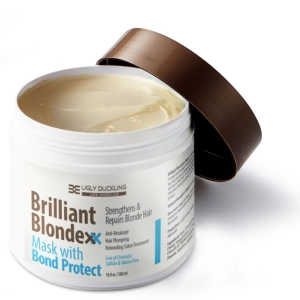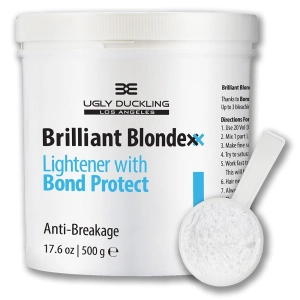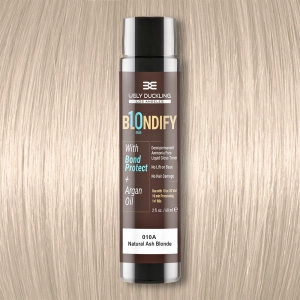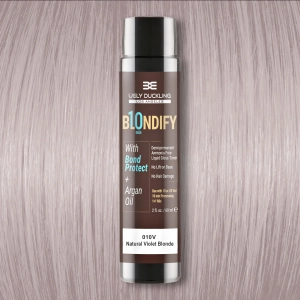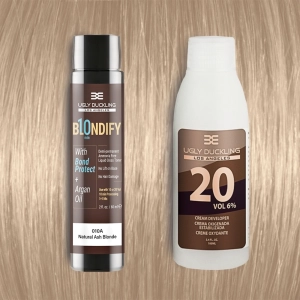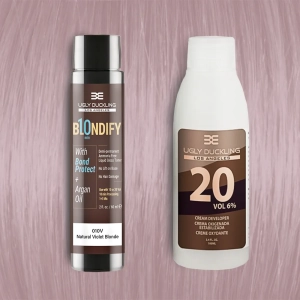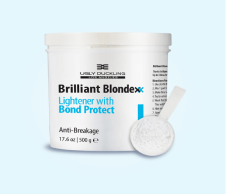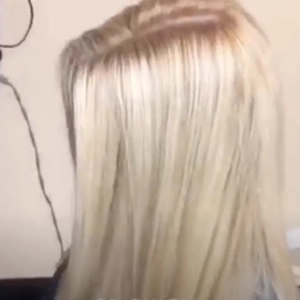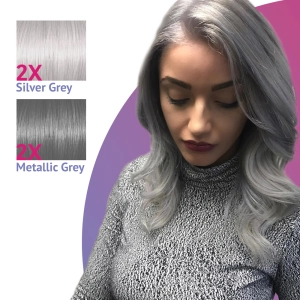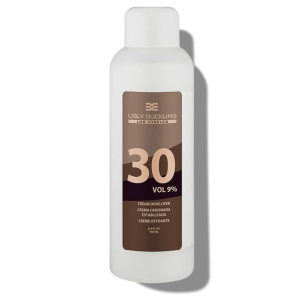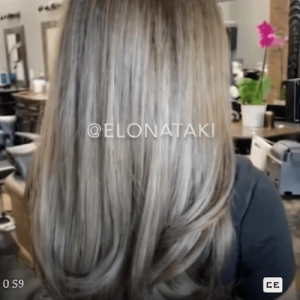Hair Breakage - A Common Issue Among Blondes
Do you have blonde hair that is snapping off?
Blonde hair is inherently more fragile and thinner than other hair.
Especially when it has been bleached and lightened.
However, if you are sensible and take the right steps, you can prevent this.
In this article, we are going to go through 7 steps you should take.
Do these 7 things and you should be able to considerably reduce hair breakage and fragility issues.
Blonde Hair Can Be More Prone to Breakage
.png)
Bleached blonde hair can be thinner & more prone to breakage
Being blonde is great.
But as any blonde can attest, hair breakage and hair snapping off can be issues which many blondes face.
The reason for this is simple.
Blonde hair is thinner than brown hair.
And contains less melanin - that's why it is blonde.
This tends to make blonde hair more fragile and more prone to damage including breakage and thinning.
The process of bleaching and coloring hair can also be harsh and cause damage to the hair strands, leading to hair breakage.
Plus if the hair has been bleached or lightened, it will be thinner anyway.
7 Steps to Deal with Hair Breakage
In this article, we have outlined 7 measures that anyone can take.
Every one of them will help reduce hair breakage.
Do all of them together and you should notice a real difference over time.
No more hair breakage and no snapping whatsoever.
Keep reading through all these steps.
The 7th one in particular is new technology, in high concentration, and will really help breakage issues significantly.
Hair breakage from bleach: the number one cause for hair breakage
If you have had hair breakage issues and hair snapping issues, it is likely that at some point you bleached the hair.
And did it wrong, leading to the bleached hair breaking off.
Probably you used an inferior quality of bleach.
Or you used an inappropriate developer strength.
Or you left it on too long because it was not working.
Or you over processed parts of the hair which had already been bleached in the past.
Do any of these sound familiar?
Don't worry. We will go through all of them now.
Step No. 1: Use Quality Bleach
The very first thing to check if you have breakage issues when going blonde is the bleach that you are using.
Unfortunately not all bleaches are the same.
Poor quality bleaches commonly sold at many beauty stores do not have enough lifting power.
This is really the number one thing that counts.
Without good lifting power, stylists and women are unable to get melanin or color build-up out of the hair.
And they end up using 40 Vol developer to compensate.
The combination of poor quality bleach and over-strong developer literally blows the hair cuticle apart.
So the first thing to get right is to use a quality bleach.
Brilliant Blondexx Bleach - The Bleach To Use to Prevent Hair Breakage
We would suggest Ugly Duckling's Brilliant Blondexx Bleach.
Brilliant Blondexx contains Bond Protect.
It's one of the very few bleaches on the market that does so.
At the same time, it has a powerful, effective lift: u
Up to 7 levels on natural hair.
And because of the Bond Protect, it's safe and gentle at the same time.
Meaning that you can use it near the root area and even near the scalp.
The quality of the mix with this bleach is also different from other bleaches.
It's exceptionally creamy, almost oil-like and pure white and very smooth.
If you have used other bleaches in the past, try it and you should immediately notice the difference.
Brilliant Blondexx Hair Bleach - contains Bond Protect
Hair by Elona Taki
Step No. 2: Use the Correct Developer Strength
The next thing you need to get right is to use the correct developer strength when you bleach.
With Brilliant Blondexx, we would suggest you use 20 Vol developer for up to 3 levels of lift, as well as whenever you are bleaching near the scalp.
For lifts above that, 30 Vol should be used.
40 Vol should never be used in conjunction with bleach.
Also, remember one thing.
If you need to make 2 bleaching applications (for example, in color build-up situations) the rule is use 20 Vol developer for the 2nd application.
Step No. 3: Get Your Right Bleach Mix
Now some tips for succeeding your bleach mix:
When making your mix, always make a nice wet mixture (1 part bleach to 2 parts developer).
Mix until it's a really smooth, consistent, wet paste.
This will help you apply the bleach properly and really saturate (ie coat) the hair.
Which in turn will mean that the hair will process and lift rapidly.
Meaning less breakage and less trauma to the hair.
Step No. 4: Don't Apply Bleach onto Previously Bleached Level 10 Hair

Take care when you bleach not to overlap
Another bleaching error is to overlap onto parts of the hair which have already been bleached to level 10.
Very often this is the case for lengths or even ends, which tend to be thinner anyway because they are older hair.
Do not do this. It will lead to major damage.
Instead, make sure not to overlap when bleaching.
And if by chance you do - which is totally normal - wipe back the mixture during processing using a damp cloth.
Step 5: Don't Over-process your Bleach Mix - Especially On the Ends & Scalp.
Remember: the level you need is very very pale yellow level 10.
If you rinse off too soon, you won't get to a nice blonde.
And if you rinse off too late, you risk hair breakage.
It is therefore really important that you process each part of the hair for the right amount of time.
The first critical decision is where to apply first.
Always apply on the part that needs the most lift first.
If, for example your mid-lengths are orange-yellow but your ends are white, you need to apply on the mid-lengths only at first.
Wait first until those parts have lifted and are showing yellow.
Then the next critical decision is knowing when exactly to extend.
Decide how much you need to lift the rest of the hair and apply on those parts accordingly.
As for the roots, they can process extremely quickly due to the heat coming off the scalp.
It's a good idea to apply bleach separately to those areas so that you can control, watch and rinse at the right moment.
WATCH VIDEO: HOW TO BLEACH & TONE WITH BRILLIANT BLONDEXX
Hair by Elona Taki
Step No. 6: Tone with Blondify Ammonia-Free Toners After Bleaching

Blondify Toners Contain Bond Protect and are Ammonia-Free
If you have hair breaking off and thinning, and you are looking to go blonde, we suggest you use ammonia-free toners.
We would recommend Blondify toners.
They tone the har very effectively, as you can see in the image above.
At the same time, they are ammonia-free and hence very gentle.
They also contain Bond Protect.
And they work in only 10 minutes.
Meaning, that they work very fast and very gently.
They are currently available in Natural Ash Blonde and Natural Violet Blonde colors.
But more colors are coming shortly.
Using them is very easy. They are liquid toners, so you can make a mix with 20 Vol developer in an applicator bottle.
Then just pour them over the hair and rub in thoroughly.
Then rinse after just 10 minutes processing time.
.jpg)
Blondify Natural Violet Blonde
.jpg)
WATCH VIDEO: TONING WITH BLONDIFY AMMONIA-FREE TONERS WITH BOND PROTECT:
Hair by Elona Taki
Step No. 7: Don't Use Excessive Heat When Styling
Regular use of heat styling tools like flat irons, curling irons, and blow dryers can also cause hair breakage and thinning.
The high heat from these tools can damage the hair shaft, making it more prone to breakage.
We would suggest that you turn the heat way down.
Even if it takes longer, it will be far, far kinder to your hair.
Step No. 8: Don't Over-Wash Hair
Washing your hair too often can strip your hair of its natural oils, leading to dryness and breakage.
Over-washing can also weaken the hair strands, making them more prone to breakage.
When washing, favor professional hair products - especially acid, sulfate-free products.
Avid means that the hair is returned to its natural pH state and the cuticles are closed as a result - leading to healthier, stronger hair.
Sulfate-free means that the pores don't get clogged up unnecessarily.
All Ugly Duckling hair care is both acidic and sulfate-free,
Step No. 9: Use Treatment Products Aimed at Thinning Hair & Breaking Off Hair
Brilliant Blondexx Shampoo & Mask - recommended for hair breakage and thinning hair.
The best way to treat hair breakage and thinning on a long term basis is to use a good quality treatment range.
For that, we would suggest Brilliant Blondexx Shampoo and Mask.
It's an acid-based, professional treatment range which is used by stylists who work with blonde hair.
If you have concerns about hair breakage, this is what we would suggest you use.
It contains Bond Protect (maleic acid) in very high concentrations.
This maleic acid works to build up hair bonde from the inside, making hair thicker and stronger.
It will strengthen hair bonds and tend to make hair plumper and stronger.
It is sulfate-free, which means no build-up on the pores.
And it's acid-based, meaning that will help close the cuticle and prevent split ends - which lead to breakage in the long run.
If you use this range consistently, you should find that it strengthens hair strands, reduces breakage, and restores the hair's natural fullness.
Meaning that the hair physically becomes thicker and stronger.
You should notice this everywhere, but especially so on the ends, where hair has a tendency to become finer.
How to Use Brilliant Blondexx Anti-Breakage Treatment Products
You can use this range in 2 ways.
The first is while bleaching the hair.
If you are bleaching hair, use Brilliant Blondexx shampoo and mask right away after bleaching.
This is when the hair cuticle is open, so by using it at this stage, you are allowing the ingredients to penetrate all the way in to the hair cuticle.
When using the mask, leave on for at least 10 minutes, ideally under a heated towel.
Then rinse.
The second way is in place of your regular shampoo and conditioner.
Use them instead of your regular shampoo and mask.
Remember, not to use excessively hot water when washing and only wash 3 times a week: not every day.
You will notice a difference to the strength of your hair with the progressive use of these products over time.



.png)
